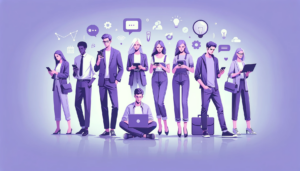Industry insights: Fusing generations at work amid demographic shifts
- 5 Min Read
As Gen Z places new demands and expectations on their workplace, fusing generations is critical to protect engagement and retention
- Author: HRD Connect
- Date published: Sep 5, 2023
- Categories

The workforce is evolving. With the entrance of new generations, organizations must cope with the challenge of integrating diverse talents, expectations, and demands. This article explores the latest research and analysis on fusing generations across demographic boundaries and how organizations can draw on this research to engage and retain their workforce.
Fusing generations amid changing workforce demographics
Changing demographics in the workplace are leading to a shift in what motivates employees. One of the most pressing issues is fusing generations, including the gap between Gen Z and older generations. Gen Z, born between 1997 and 2012, is the newest generation to enter the workforce. They bring with them unique perspectives, values, and expectations. The younger workforce, particularly Gen Z, is pushing back against the traditional “hustle culture.” They are seeking work that aligns with their values and supports their well-being.
Research from ADP in 2022 found that Gen Z values flexibility. 64% of workers considered leaving a job that did not allow for flexible work conditions. This shift away from the traditional nine-to-five office job is leading to a redefinition of what constitutes a high-status job, with careers in entrepreneurship, sports, music, and fashion gaining prestige.
However, this transformation is not without its challenges. Research from Deloitte found most business leaders (87%) believe that developing the right workplace model is important or very important to their organization’s success. However, only 24% feel their organization is very ready to address this trend.
To navigate these changes, organizations need to let the work drive the workplace decisions, design the experience in service of outcomes and value, and empower the individual, the team, and the ecosystem.
Allow each generation to define their roles
In the second part of the ‘Why You Need To Write A New Contract With Top Talent’ series, authors Billies and Rising advocate for an approach that empowers top talent at all levels to maximize impact. This involves distributing authority to employees to shape their own roles in the company, regardless of their levels.
This approach is particularly relevant in the context of fusing generations in the workforce. Each generation brings unique strengths and perspectives to the table. By empowering them to shape their roles and rewarding them for their contributions, organizations can create an inclusive environment that values diversity and fosters collaboration.
An option is to have employees create an individual development plan (IDP). An IDP can be as simple as a list of long-term and short-term career goals, with a list of desired training courses and developmental assignments. The real benefit of an IDP is the career conversations that the employees have with their supervisors, mentors, and career coaches, and it quickly brings to light the differences each employee (and generational cohort) may have in their career expectations.
Establish skills development
Another way to drive talent integration is through skill development. According to Bill Brantley’s article on government work, skill development is a top priority for 83% of employees, and 88% have already taken steps to enhance what they can deliver at work. Millennials and Gen Z are especially concerned about their career development.
Mentoring programs are a great way to start your development marketing campaign. They are also an excellent method for young employees to learn from the senior leaders’ own experiences. Closely related to mentoring is coaching. A successful coaching program can be created with an initial investment for coach training of supervisors. The benefit of coaching is to help employees develop a vision for their future development.
Consider shifting compensation and benefits expectations
In an interview with CHRO360, Shawn Gibson, Senior Director, HR operations at Info-Tech Research Group, emphasized the importance of a wider view on compensation. This involves everything from financial incentives to mental health offerings. This is crucial in meeting the diverse expectations and demands of different generations.
For instance, Gen Z workers value work/life balance and mental health, and organizations can attract and retain this talent by offering mental health support and a swathe of other resources indicative of a positive company culture. In many cases, they already do. According to SHRM, more than three in five (63%) employees say that having access to better mental health resources at work would improve their mental health, and this is especially true among younger employees – about seven in ten in the case of Gen Z (71%) and Millennial (69%) workers.
One of the most notable trends is the breaking of ‘M’ taboos – menstruation and menopause. Organizations now recognize these as essential aspects of employee well-being. Menstruation impacts about half of the workforce, yet statistics show that 74% of people who experience menstruation feel it’s necessary to hide period products at work, and 60% feel uncomfortable discussing the topic with colleagues or managers. New generations of workers are challenging the silence and stigma around ‘M’ taboos, with organizations like the National Trust, Diageo, BBC, AstraZeneca, Tesco, and Lloyds Bank implementing menopause-related policies and education.
Fusing generations to protect retention
From the same SHRM findings, we learn Gen Z and Millennial workers report negative mental health impacts at twice the rate of Boomers and Traditionalists. Nearly half of these younger workers say they feel stressed once a week by their work, and they report elevated levels of feeling depressed, overwhelmed, lonely, and disengaged.
Fusing generations in the workforce requires understanding the unique needs and expectations of each generation, providing supportive resources, and fostering a culture of respect and inclusivity. By doing so, organizations can not only improve the mental health and well-being of their employees but also enhance productivity and retention.









